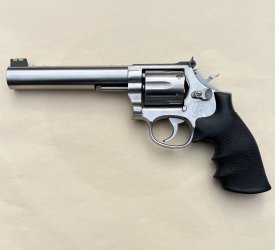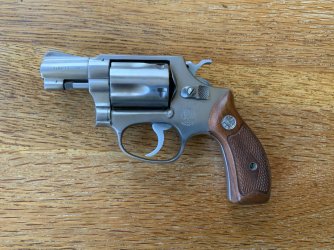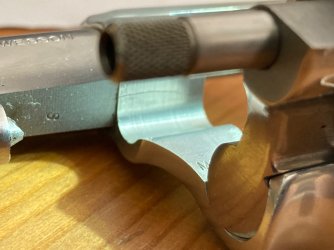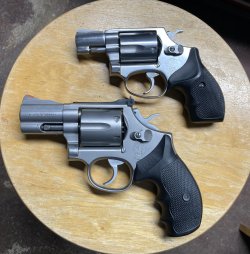Exchipy
Member
Quote from Gunz50, posted elsewhere:
“[Consumers] were only looking to get the few stainless guns that were already in short supply and [ ] that were being sold at full MSRP and above[. S]stainless steel revolvers were the hottest new thing back then, in the 70's you needed to be on a wait list at your local ffl to get one of any cal. and barrel length,I know because I was on several wait lists for a long time.”
AMEN, BROTHER!
In the early 1970s, when the California Highway Patrol first authorized the carry by its officers of 6” S&W stainless steel .38/.357 revolvers, no such revolvers were commercially produced by S&W. So, I managed to locate, and purchase at a very substantial premium above the MSRP, one of the very first Model 66 Stainless Combat Magnum revolvers available in the entire SF Bay Area. I then had my favorite pistolsmith at the time replace the factory 4” barrel with a 6” heavy stainless steel barrel of PPC configuration, just like the blued steel S&W Model 15 PPC gun I used in competition. From my PPC competition experience, I already knew that my Hoyt break-front duty holster could easily close completely around a heavy PPC barrel, with absolutely no impairment of its lightning quick draw. So, I started carrying that modified Model 66 on patrol duty.
During my first Squad Inspection with that revolver, the Officers of the San Jose Squad all stood in line at attention, with their blued steel revolvers held smartly in front of them at 45 degrees, cylinders open and ready for inspection. When he got to me and my shiny stainless steel heavy barreled Model 66, the Inspector abruptly stopped, turned, and glared at my Captain, who then sheepishly explained, “We checked; it’s authorized.” So, it seems like I was probably the very first CHP Officer to carry an authorized stainless steel revolver as a duty weapon.
That PPC barreled Model 66 looked a lot like this Model 686 I put together last year:

Except that the 66 had the regular S&W walnut target grips.
Unfortunately, that Model 66 died splendidly in the line of duty, destroyed while testing a late lot of Super Vel .357 ammo in a Ransom Rest at the CHP Academy Range the very next year. That over-achieving ammo had split the forcing cone along the bottom, clear to the shoulder, launching the corresponding threaded left side of the frame off into space, and thereby releasing the barrel to fall to the concrete where it rang like a bell. The story of that revolver’s replacement is particularly entertaining, but too long for here.
“[Consumers] were only looking to get the few stainless guns that were already in short supply and [ ] that were being sold at full MSRP and above[. S]stainless steel revolvers were the hottest new thing back then, in the 70's you needed to be on a wait list at your local ffl to get one of any cal. and barrel length,I know because I was on several wait lists for a long time.”
AMEN, BROTHER!
In the early 1970s, when the California Highway Patrol first authorized the carry by its officers of 6” S&W stainless steel .38/.357 revolvers, no such revolvers were commercially produced by S&W. So, I managed to locate, and purchase at a very substantial premium above the MSRP, one of the very first Model 66 Stainless Combat Magnum revolvers available in the entire SF Bay Area. I then had my favorite pistolsmith at the time replace the factory 4” barrel with a 6” heavy stainless steel barrel of PPC configuration, just like the blued steel S&W Model 15 PPC gun I used in competition. From my PPC competition experience, I already knew that my Hoyt break-front duty holster could easily close completely around a heavy PPC barrel, with absolutely no impairment of its lightning quick draw. So, I started carrying that modified Model 66 on patrol duty.
During my first Squad Inspection with that revolver, the Officers of the San Jose Squad all stood in line at attention, with their blued steel revolvers held smartly in front of them at 45 degrees, cylinders open and ready for inspection. When he got to me and my shiny stainless steel heavy barreled Model 66, the Inspector abruptly stopped, turned, and glared at my Captain, who then sheepishly explained, “We checked; it’s authorized.” So, it seems like I was probably the very first CHP Officer to carry an authorized stainless steel revolver as a duty weapon.
That PPC barreled Model 66 looked a lot like this Model 686 I put together last year:

Except that the 66 had the regular S&W walnut target grips.
Unfortunately, that Model 66 died splendidly in the line of duty, destroyed while testing a late lot of Super Vel .357 ammo in a Ransom Rest at the CHP Academy Range the very next year. That over-achieving ammo had split the forcing cone along the bottom, clear to the shoulder, launching the corresponding threaded left side of the frame off into space, and thereby releasing the barrel to fall to the concrete where it rang like a bell. The story of that revolver’s replacement is particularly entertaining, but too long for here.
Last edited:



